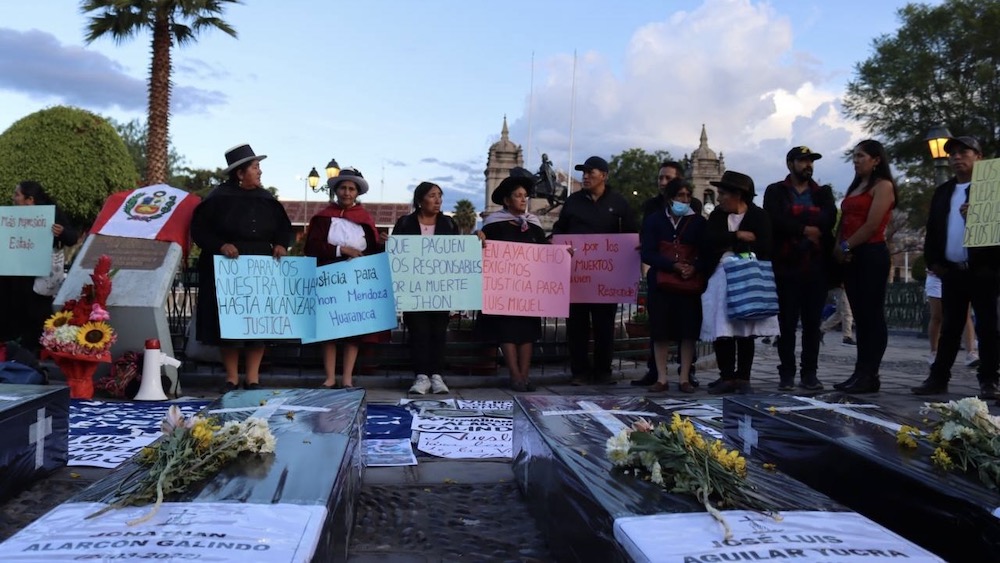Peruvian Prosecutor Mirela Coronel is investigating 20 soldiers over charges of attempted homicide for their role in repressing the mass anti-coup protest in Ayacucho, Peru on December 15, 2022. On this day, 10 protesters were killed and over 66 were injured. Coronel alleges that the military forces involved in the repression had the intention of murdering the demonstrators.
The investigation began on February 13, 2023, two days after the independent media outlet IDL Reporteros published the audiovisual report “Radiography of homicides”, which is an exhaustive and well-documented reconstruction of the brutal actions of the Peruvian Army in Ayacucho, showing that the deaths of Josué Sañudo, Edgar Prado, Clemer Rojas, Cristofer Ramos, José Aguilar and Leonardo Hancco were committed intentionally by the soldiers involved.
Read more: ‘They shot them down like animals’: massacre in Peru’s Ayacucho
The accusation is also based on an analysis of the wounds of the dead and injured from the protests, which confirms that “there was a pattern of behavior” on the part of the military. The investigation concludes that the army deliberately aimed at the bodies of the people and fired at them with Israeli-made Galil rifles. The accused include seven officers who, according to the prosecution, did not stop the deliberate killings of demonstrators at the Ayacucho Airport.
The indictment also involves three Generals of the Armed Forces (Gómez de La Torre, González Bohorquez, and Vera Impenza) who, according to the prosecutor Coronel, were “the links in the chain of command during the actions against the protest in Ayacucho”. Another ten defendants belong to a special army unit that carries out anti-terrorist operations, especially against the remnants of the Sendero Luminoso. Still, on this occasion, they acted against the unarmed civilian population.
One of the accused, Lieutenant Colonel Jimmy Vengoa Bellota, said that they never had access to a plan on how to act against the protests, and that they only received an assault rifle to defend their position: “The mission was [to ensure] that the demonstrators did not enter the airport…We have not been provided with equipment in general…we should have received for this type of protest…radio, shields, rods, knee pads. The only thing we received was a Galil armament.”
Although all the soldiers declared that they only fired into the air and, therefore, denied having used their rifles against the unarmed population, more than 100 witnesses testified before the Prosecutor’s Office that the soldiers aimed their weapons directly at the civilian population and that they fired directly at people’s bodies. Furthermore, as shown by IDL Reporteros, in a report titled “This is how the army killed in Ayacucho”, there are dozens of photos and videos in which several military personnel can be seen pointing and shooting at the civilian population.
The coup against Pedro Castillo
On December 7, 2022, a coup d’état was carried out against the president of Peru, Pedro Castillo, by the Armed Forces and the majority of the right-wing opposition parties who, by a legislative decision, declared Castillo’s “permanent moral incapacity”. A few hours later, Vice President Dina Boluarte became President of Peru and began to align herself with the conservative sectors of Peruvian congress.
In the months following the coup, hundreds of thousands of people, largely hailing from the historically excluded countryside of Peru who felt identified and represented by Castillo, organized mass mobilizations in different parts of the country to demand Boluarte’s resignation, new elections, and a new constitution. Dina Boluarte and her coup government called for brutal and swift repression of these protests.
During the mobilizations, which lasted several months into 2023, more than 55 people died (10 of them killed on December 15, 2022, in Ayacucho) and hundreds were injured. On January 9, 2023, 17 protesters were killed and over 60 were injured in Juliaca, Puno.
The Inter-American Commission on Human Rights (IACHR) concluded that in some cases there were extrajudicial executions and massacres, as well as disproportionate use of force. Families of the victims as well as human rights organizations and progressive groups have been demanding truth and justice about those killed by the violent state repression.





